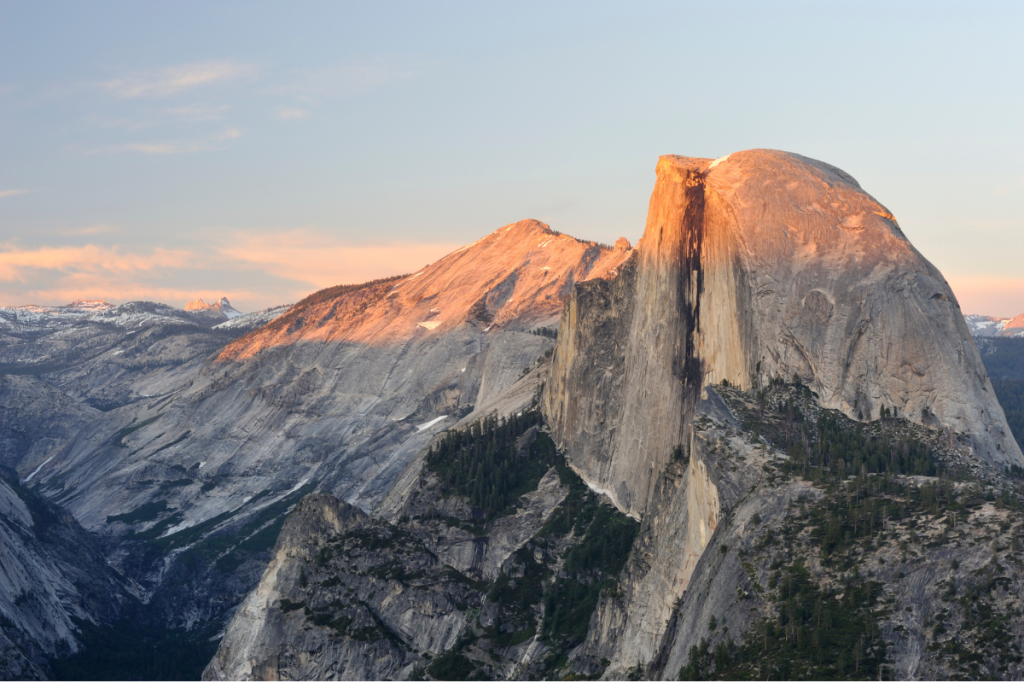Half Dome, in the stunning Yosemite National Park, is an iconic hike in North America. This 14-16 mile round-trip trail, the Half Dome hike, attracts thousands of hikers yearly. The arduous hike to Half Dome, traversing Little Yosemite Valley, the Mist Trail, and the John Muir Trail, requires a Half Dome permit and suitable preparation.
The challenging climb involves scaling the Half Dome cables to reach the summit, where the unforgettable view of Half Dome rewards adventurers. Seasoned hikers are equally challenged, emphasizing the importance of entering this hike in Yosemite fully prepared.
From the trail to Half Dome to the exhilarating descent via cables, this blog by the Rogue Traveler equips you with the ultimate survival guide and essentials needed for a safe and memorable Half Dome trekking experience.
Initial Planning
The first step to successfully hike Half Dome is careful initial planning. This involves two critical aspects: Securing the necessary permit is crucial to your Half Dome hike planning.
Entry to Yosemite National Park requires an entrance fee, but hitting the Half Dome trail specifically requires a separate Half Dome permit. Permits are issued through a lottery system due to the popularity of this iconic hike. Remember, the national park prioritizes safety; limiting the number of Half Dome hikers prevents overcrowding on the trail and at the cables.
Choosing a date for your hike to Half Dome isn’t just a matter of personal convenience. The best time to hike Half Dome is generally from late May to early October when the cables are up. However, factors such as weather conditions, trail closures, and your personal fitness level should also influence your decision. Yosemite National Park can be subject to abrupt weather changes, so your dates must be flexible.

Late spring and early summer are prime times for witnessing the splendor of the Mist Trail and Little Yosemite Valley. Because the Half Dome hike is a challenging day hike, consider spending a few days acclimating to the elevation in Yosemite before you climb Half Dome.
John Muir once said, “The mountains are calling, and I must go.” Heed the call with the right planning, securing a permit, and choosing the perfect date. Do stick with us as we move onto the next phase – preparing for the hike. Throughout this process, immerse in the rich wilderness, scale the panoramic Half Dome cables, and treasure the stunning view of Half Dome and beyond. It’s more than just a hike – it’s a journey into the heart of nature.
Training & Preparation For The Half Dome Hike
Sure, hiking Half Dome is a fantastic day hike, but it is also a strenuous undertaking that demands adequate training and preparation. This section delves into the two key areas: Fitness training and acclimating to altitude.
Fitness Training
The Half Dome hike, from the base of the cables to the summit and back, is not for the faint-hearted. This part of the hike calls for an intensive training regime:
- Cardio: Be prepared for a long hike. Aim for 60-90 minutes of cardiovascular exercise 4-5 days a week. Running, cycling, and swimming can help build your endurance.
- Strength Training: As you’re hiking Half Dome, you’ll navigate steep granite steps. Training programs should include leg strength exercises like squats and lunges.
- Balance and Flexibility: Yoga and balance training will help you maintain stability and avoid injury on the trail.
- Cable Training: Build upper body strength to tackle the cables on Half Dome. Pull-ups and arm curls can be highly beneficial.
Don’t forget to rest and hydrate profusely, especially a few days before your hike date.
Acclimating To Altitude
Yosemite’s Half Dome stands proud at over 8,800ft (2,680m), and altitude sickness can be a concern. Acclimate yourself:
- Start Low, Go Slow: Spend a couple of extra days in Yosemite National Park, using this time to explore shorter trails and adjust gradually.
- Stay at Little Yosemite Valley Campground: A night spent here will help your body acclimate to the altitude before you march towards the summit.
- Keep Hydrated: Drink plenty of water to reduce the effects of altitude sickness.

Remember, Half Dome is not a place to push your limits beyond safety. Your training should focus on enabling a safer, more enjoyable hiking experience. Check the National Park Service website or a reliable park travel guide for important updates and a detailed Half Dome hike map. From the tranquil Merced River in Little Yosemite Valley to the panoramic views from the Half Dome cables, a well-prepared hike to this Yosemite icon will surely be one for the books!
Essential Gear For Hiking To The Half Dome
Hiking Half Dome at Yosemite National Park is one unforgettable adventure. But whether you’re a novice or a seasoned hiker, having the right gear in your backpack is crucial. Check off this list of must-haves before you set off:
Water & Food
Stay fueled along the trail to Half Dome:
- Water: The rule of thumb for a strenuous day hike like Half Dome is a minimum of 1 gallon of water per person. Hydrate before, during, and after the hike.
- Food: Pack high-energy, easily digestible foods. Think trail mix, protein bars, and fruits. Remember, this isn’t a picnic – eating is for the energy to hike Half Dome.
Hiking Boots
Despite the hype of ‘athlete conquers Half Dome barefoot,’ don’t try it. Sturdy, well-worn hiking boots are your best friend for the challenging Half Dome hike.
- Boots: Choose sturdy, supportive, and waterproof hiking boots with excellent traction that are ready for the granite Sub Dome and Half Dome cables.
Biodegradable Toilet Paper & Portable Toilet
Half Dome hikers, here’s an important reminder:
- There are no restrooms along the trail to Half Dome after Little Yosemite Valley. But ‘nature’s call’ can happen without notice – pack a lightweight portable toilet and/or biodegradable toilet paper.
Safety Gear
Maneuvering the Half Dome cables and summiting the top of Half Dome is no walk in the park:
- Gloves: Protect your hands with a pair of durable gloves when you climb the cables, both ascend and descend.
- First Aid Kit: Trail upsets happen, so be prepared with a basic first aid kit.
- Headlamp/Flashlight: Don’t underestimate the Half Dome hike; it can turn into a night hike.
Echoing the National Park Service, your safety depends on your good judgment, adequate preparation, and constant attention. A Half Dome hike permit may get you onto the cable route, but only with the right training, preparation, and gear can you conquer Yosemite’s Half Dome, a.k.a; the best hike in Yosemite! So gear up, respect the laws of nature, and enjoy the view from the top! The sight of Yosemite Valley from the summit of Half Dome? Unbeatable.

On The Trail
Embarking on the Half Dome hike at Yosemite National Park is not a stroll. To reach the top and back safely within daylight, you’ll need to get your boots on the Half Dome trail when dawn’s barely breaking. An early start will help you avoid the mid-day sun heat and possible afternoon thunderstorms, not to mention the bottleneck chaos at the base of the cables.
Monitor Your Body
This long hike necessitates that you’re in tip-top shape before and during the trek. Pay attention to your body signs. Feeling dizzy? Take a breather and hydrate. The Half Dome trail is demanding, but remember: you’re hiking Half Dome for an enriching, memorable Yosemite experience, not a grueling marathon.
Embarking on the Half Dome hike in Yosemite requires gusto, but more than that, preparation is key. Secure your Half Dome hike permit, research the trail via the John Muir trail guide, understand the route to Half Dome, and respect the rules set by the National Park Service.
The sweet reward is worth the grueling journey: triumphantly looking down on Half Dome conquered under your hiking boots, the majestic views of Yosemite Valley sprawling beneath you, and the sense of achievement as you descend the cables.
Remember, your round trip to Half Dome is no ordinary day hike. It’s a serious undertaking that requires a diligent spirit. It’s a journey equivalent to climbing a mountain, and like every mountain, it must be treated with respect. As the National Park Service, your guide to the best undertakings at the park, will tell you, “Half Dome is not a place for unprepared visitors—irrespective of the date, permit to hike or not. Prepare, or beware.”





0 Comments